Whenever an American friend comes all the way to this continent, I always make an effort to meet up, wherever they may choose to spend their holiday.
This July, I spent a week in the company of my good friend Maureen, who I first met back in the trenches at Vogue magazine.
Although Aix is only about 6 hours from Viareggio by car, I couldn’t deal with the long drive alone in my wimpy Yaris. Train routes had been dramatically cut back due to the Covid infestations, as were the air routes. Normally there are trains direct from Marseille to many places in Italy. But not this year. I ended up finding the only itinerary available that didn’t last 20 hours: Marseille-Frankfurt; Frankfurt-Pisa. Pisa is very close to the small coastal town of Viareggio, where Maureen started her Italian stay.
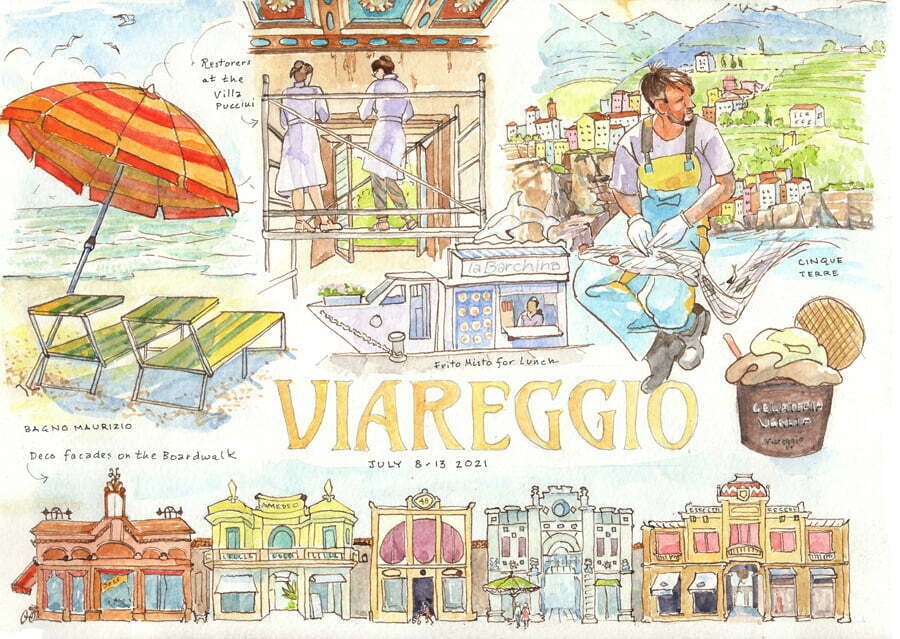
Viareggio was once an elegant resort town for wealthy Italians, as is apparent by the charming esplanade that backs onto the beaches. All the buildings are in Art Nouveau and Art Deco styles. Alas they are mostly in disrepair, or house tourist shops at ground level. The social-gathering places and theatres they once contained no longer are part of our contemporary way of life.

This flower-filled beach town is still a destination spot for vacationing Italian families (maybe not the rich&famous). I loved watching the Italian children interact with each other (already using the exaggerated arm gestures so stereo-typically Italian) and with their parents, who seemed very affectionate, with lots of kissing and hugs—something a joy to witness. The boys seemed like little men, the girls very free, compared to French children, who seem to me as an American, overly disciplined and scolded.
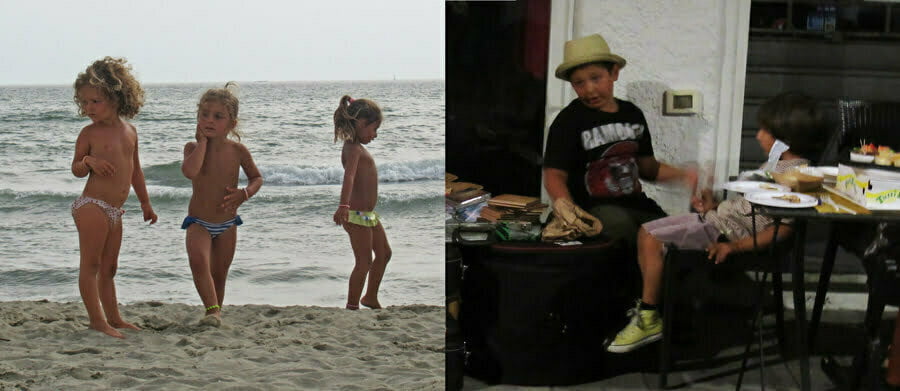
We chose to go to a private beach, Maurizio’s, in order to benefit from a parasol and lounge chairs. Maurizio’s son Stefano was especially nice to us, giving us the spot nearest the sea. The first day had big breakers such as I’ve never experienced in the Mediterranean. It was these rough waters (fun to play in, but not on a boat) that delayed our day-trip boat ride to visit the Cinque Terre region just north of us on the coast. We made the trip another day.
Viareggio still being a fishing town, we were able to witness some of the labour necessary for bringing us fresh fish: At a quai near the beach we saw a fishing boat, back from their early morning sortie. Every day these five fisherman hand-extract the fishes caught in their nets. They were cheery fellows and let us talk with them (Maureen practicing her Italian) and take pictures. We were humbled by the hours of patience it takes to carefully comb through the tangle of nets every day.
At the same quai was docked La Barchina, (small boat) serving up fresh deep-fried fish, squid, octopus and other local sea creatures. Of course we had to try their fare, which was very satisfying.
The five former fishing villages, Monterosso, Vernazza, Corniglia, Manarola and Riomaggiore all make up the Unesco Heritage site of Cinque Terre. Today these picturesque villages are entirely transformed into tourist towns. We stopped briefly at Vernazza, and stayed longer at Monterossa, where the Church of San Giovanni Battista displayed its close ties to the fisherfolk who lived and toiled there. Among the various images relating to the sea was this curious ship, which floats over the congregation.

Floating along the coast, we had a great view of the mountains behind all the villages. One in particular looked as if it still had snow! On closer inspection, we realized the whiteness was in fact the huge scars caused by the Carrara marble quarries. We were to see plenty of the pure white, honed marble when we got to Florence. On the ride back, many of the passengers slept.
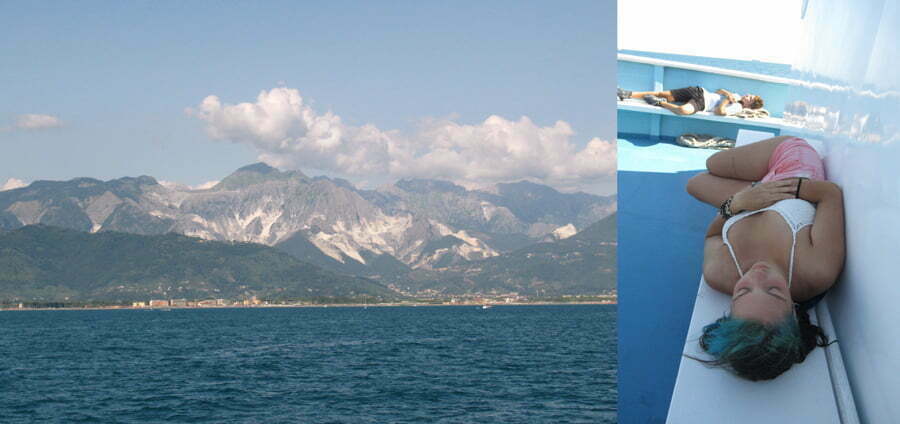
On another day, we took a bus to the nearby Lago di Massaciuccoli, on the shores of which Giacomo Puccini had his home (He liked to shoot waterfowl). I wanted to go in order to get some photos of the wetlands; something not possible, as no rowboats were for hire. As consolation, we visited the Puccini house, which was in the process of renovation. As one Italian we met put it: “We Italians know how the do old”. It makes me happy to know so many skilled craftspeople have jobs because of the tourism industry.
The local trains are terrific in Tuscany, and we were able to easily make a day trip to nearby Lucca, the Tuscan town famous for its great wall that kept Lucca a free town all the way up until 1805 (after Napoleon’s conquering of the town, he gave it to his sister. Lucca eventually was absorbed into the Bourbon-Parma duchy, and finally became a part of unified Italy).
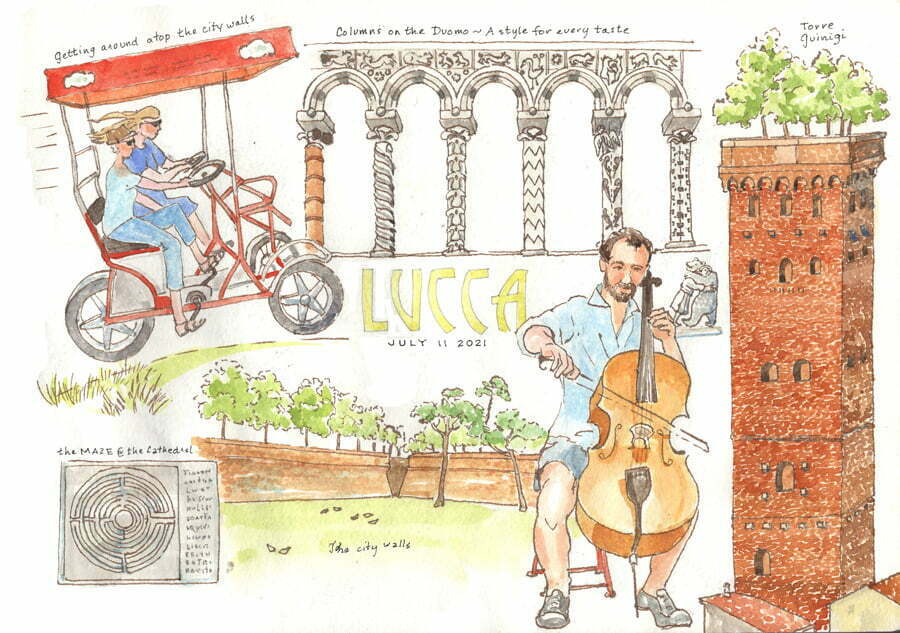
We booked a short walking tour, whose docent took around the town, pointing out highlights like the crazy Duomo di San Martino with its assortment of columns. Lucca is also famous for its array of towers, the niftiest, in my opinion, being the Torre Guinigi, with shading oak trees on top. While waiting for the tour, and after our morning cappucino, we enjoyed the music of a cellist playing Italian classical hits in an acoustically-suited loggia in the Piazza San Michele.
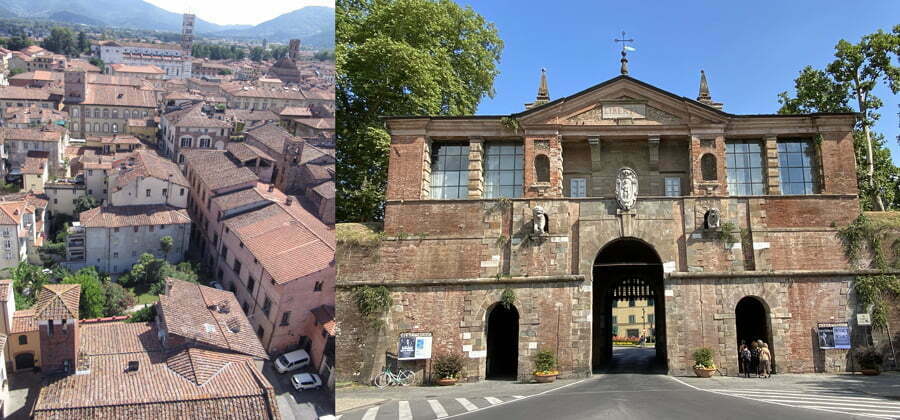
The town is a perfectly preserved medieval/renaissance heritage site. Strict laws ensure that it looks the part. For example, old Art Nouveau and Art Deco signage cannot be altered or removed. In some cases, family-owned operations such as Jewelry stores or Pharmacies are able to hold onto their distinguished identities with stylish signage. In others, your designer clothing shop just has to put up with a lavish sign for a Pizzicheria above the vetrina.
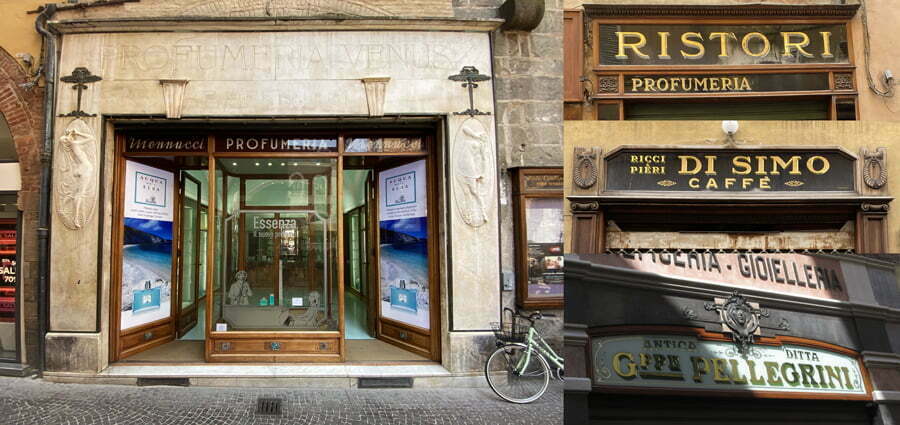
The best part of our visit to Lucca was enabled by a tourist bicycle. Maureen was to undergo knee surgery in September, so could bike, but had difficulty with long walks. Diana can walk forever, but had been permanently put off from riding after an awful fall. This goofey 4-person vehicle enabled us to merrily circumnavigate Lucca’s famous city wall. The broad top of the wall now sports green spaces, ice cream cafés, and lots of shade trees.
I’ve drawn the man-and-bear-hugging sculpture propping up one of the assortment of columns. I love the look of this church as it is riddled with images of animals—fantastic, wild and domestic, all beautifully integrated into the complex façade. In fact I loved the many, many depictions of animals in the art I saw on this trip. That these artists from long ago felt compelled to depict our fellow creatures shows how much more integral they were to human life back then. For those of you who know my art, you know that I carry out their tradition in my respect for animals.
Also on the church is a 13th-century sculpted maze with Latin inscription referring to Daedelus and Ariadne. All through our trip to Italy we felt our deficiencies in Christian iconography. Who knows why there’s a maze on the front of this Duomo. Maybe that the Church can act like Ariadne, showing us poor mortals the way?

There was lots more Christian iconography waiting for us in splendid Florence, to which we traveled from Viareggio by train. We stayed at the pleasant, and centrally-located B&B Dante Aligheri. Dante, by the way, as we know from attending one of Rocky Ruggieri‘s webinars, had been exiled from Florence, having backed the wrong side between the black & white Guelfs. As Rocky surmised, Dante was inspired by his Florentine enemies to include them in his hair-raising description of Hell. Although we can see Dante’s lavish tomb in the Basilica of Santa Croce, (along with those of Michelangelo, Machiavelli, and Galileo, among others) his body isn’t there—he died in exile and his hometown didn’t want him back until his enemies had long fallen from power. Too late, it turns out.
The B&B was located right behind the Piazza della Signoria and town Hall— Palazzo Vecchio. The plaza is large and has a covered loggia which houses some famous sculptures. The Medici lion stands guard right next to the Palazzo Vecchio. It also has an ostentatious Neptune Fountain, whose god apparently sports the face of the powerful Medici who commissioned it, Cosimo I.
We spent a day at the Uffizi. As much as I could in just one day, I tried to soak up the splendor of their art (from where I’ve downloaded these images), especially that of the Renaissance. We were privileged to see the art close up (guards don’t chase you away as they do in French museums). There was even an unfinished Leonardo painting, so I could study his process. Standing out for me was Piero della Francesca’s portrait of the Duke & Duchess of Urbino. I remember gazing at this double portrait in my parent’s Book of Famous Art (I didn’t take note of the actual title at the time) as a kid, and wondering how someone as peculiar-looking as this Duke could have become rich and famous. Of course, it was a delight to see Primavera, and the Birth of Venus in real life. But also to see the work of Boticelli’s mentor, Fra Filippo Lippi, and Boticelli’s apprentice Filippino Lippi, with the thread of their connection so apparent.
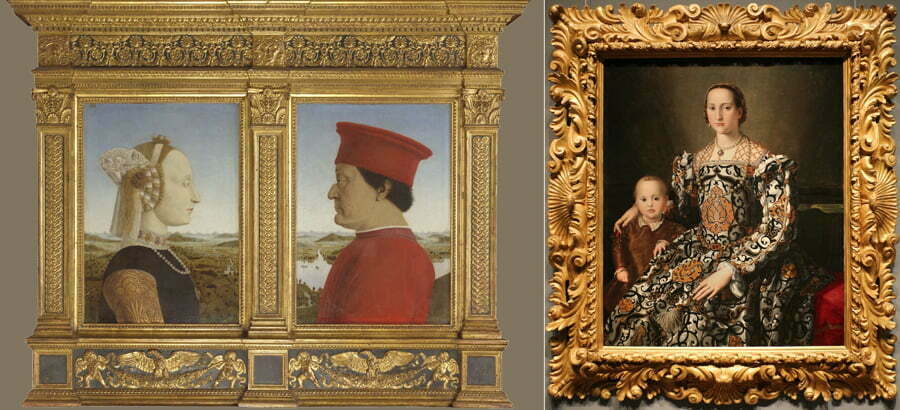
In being able to witness the actual paintings, I found new appreciation for Boticelli’s fellow Florentine from the generation after: Bronzino, and his predecessor, Pontormo. It’s hard not to like Bronzino’s exquisite portraits of remote-looking, but very stylish aristocrats.
We saw quite a pile of Annunciations, Leonardo’s and Botticelli’s standing out. And another pile of Adoration of the Magis. To me, (maybe the little girl I once was influenced me here), the most impressive aspect of these holy images (mostly triptychs)were the elaborate gilded frames. My favorite was that of Gentile da Fabriano. How did it happen that such incredible artists lived in the same town within the same hundred years? Maybe the wealth of the town had a hand in this.
All over Florence one can see the impact of the powerful Medicis. We didn’t have time to visit their Pitti Palace, but did manage to tour the adjoining 16th – 17th-century Boboli Gardens for a cool, green respite from the busy city. Handsome long vistas take advantage of the garden’s site on a hill over the Arno. Up there on this hill Maureen and I, along with quite a few tourists, had some awful wine and took in the famous view over the city at sunset in the Piazzini Michelangelo close by.
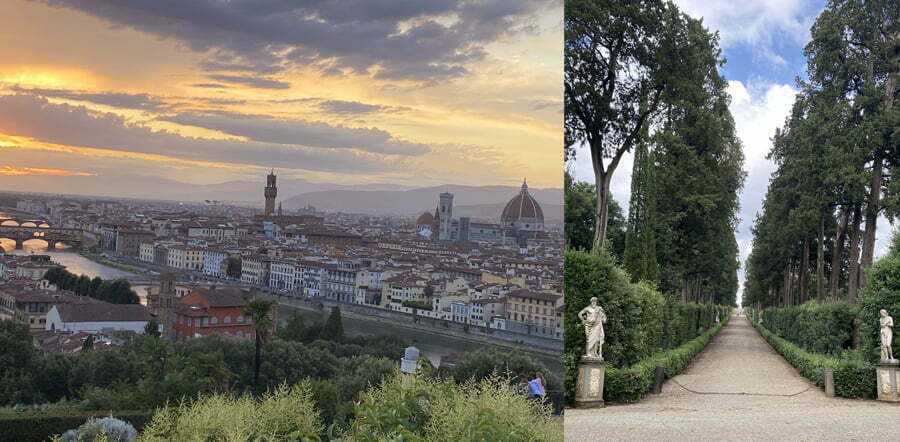
On another day we visited the Dominican abbey of San Marco (still populated), which I wanted to see because of all the Fra Angelico frescos there. As a friar in this abbey, Fra Angelico painted most of the nice frescoes on the walls of each cell. There were lots of repeats—mostly showing Saint Domenic kneeling at the crucifix. Saint Peter was also a popular choice. He is often depicted with a sword because he reacted with violence (a sin) trying to protect Jesus. I don’t know why he has a crack in his head.
We learned a bit about the difference between the Dominicans, who chose to focus on scholarship (even traveling to preach) and how that serves the Church, and Franciscans (as in the Santa Croce), who chose to see themselves as humble and practical brothers who spent their hours farming, making wine and other useful contributions to society.
An interesting fact we learned at San Marco: the novices were given larger rooms than the acclimated older monks. This was to ease their transition to the smaller cells the old hands got. An exception to this set up was the suite occupied by Savanarola, the fiery preacher who ended up being killed by the Florentine powers-that-be. His crime was railing against the corruptions of the church. He predated Luther, but was reacting to the same abuses so prevalent in the late Middle Ages. We have him to thank for the expression “Bonfire of the Vanities”.

We continued learning about the Dominican order at the Santa Maria Novella. This church and abbey had good written explanations all through the complex which familiarized us with the authors of the artwork (something not always possible at other churches). One of these inscriptions pointed out the bronze marker on the floor which marks the Solar solstice. (There’s a tiny hole in the wall which aligns with the sun only on this day, pinpointing a ray of sun to this spot).
Most of the art that isn’t in the Uffizi or Palantine Gallery (which we didn’t have time to visit) is on the walls of Florence’s churches. Visiting the Duomo proved to be impossible, as their hours were short and the lines way too long, but I did get to visit the Museo dell’Opera del Duomo where sculptures that used to grace the façade and the famous golden doors to the Baptistry are kept indoors for preservation.
Foodwise, it turns out that Tuscany isn’t for me. At every turn we saw shop windows and restaurants proudly displaying bloody slabs of meat. We did discover a great spot, Sugarello in the San Lorenzo district’s Mercato Centrale, where we had our best meal: grilled fish kebabs. Of course, pizza and pasta were always an option and the superb gelatos almost made up for all that meat.
Our last morning before going our separate ways (mine back to Aix; Maureen’s on to Lake Como) we went to the Officina Profumo-Farmaceutica di Santa Maria Novella. Domenican monks continue to make useful tinctures and especially fragrances that are truly delightful. I don’t care much for perfume, but these fragrances were so natural and fresh that i wanted all of their products. To remind me of our trip to Tuscany my apartment now carries the delicate smell of Pomegranate flowers thanks to scented wax tablets I got there.
*I’m very grateful to Maureen, for giving me these photos to use on my blog. Thank you Maureen! (see all her photos under gillespiedesigns on Instagram)
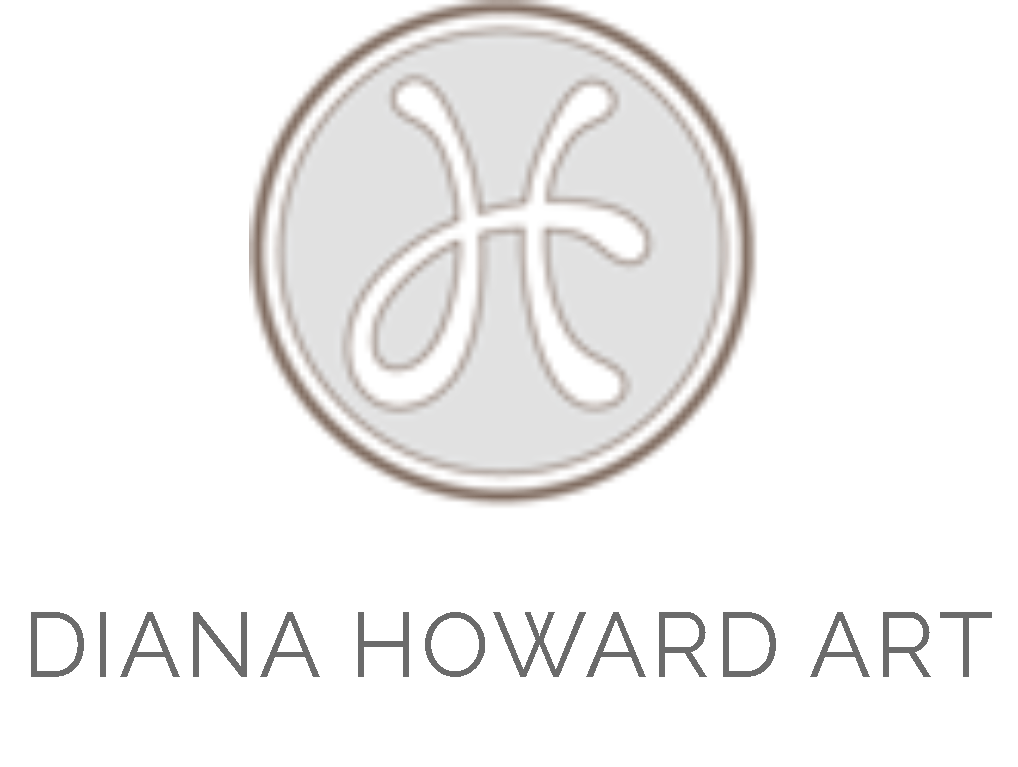
Good morning Diana
This post is beautiful, elegant, and marvelous exactly like the Tuscany you reflect.
I am happy you could enjoy this travel to Italy.
What an excellent blog post! That painting of the wall in Lucca brought me right back to my trip with Claire 35 years ago when we walked on top. Miss you and traveling with you!!
A great read. – thanks Diana.
JL and I are heading to Cinque Terre, Lucca and Firenze in late September to early Oct, so loads of info here for us. Any more clues for accommodation will be appreciated – though we’re driving and will need to have secure parking. Have you read the novel by Sarah Winman: Still Life – partly set in Florence and very beautifully written. It has inspired us to visit Florence again – it’s been 40 years since our last visit so high time! FD
I didn’t have a car, and stayed right behind the Plaza della Signoria which was super convenient.We were lucky as we traveled last year, before the hoards came back. We also stayed in the seaside town of Viareggio, which was pleasant and simple like Lavandou. Reconsider driving, unless you want to stop in the countryside to sketch, which I wasn’t able to do.There’s a great train system around there and we were able to go from the coast up to Florence, and also spend a day in Lucca, which I loved. We visited Cinque Terre via tour boat. I didn’t enjoy those villages as they are nothing but tourist traps (I liked the boat ride tho).they were packed, and I imagine will still be in Sept/Oct. Thanks for the book recommendation—always needing stuff to read!